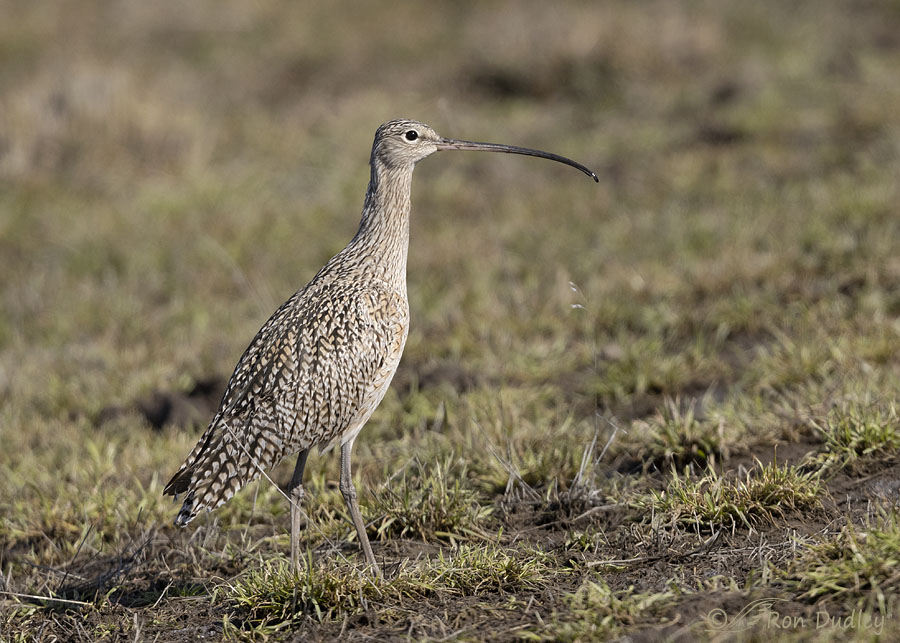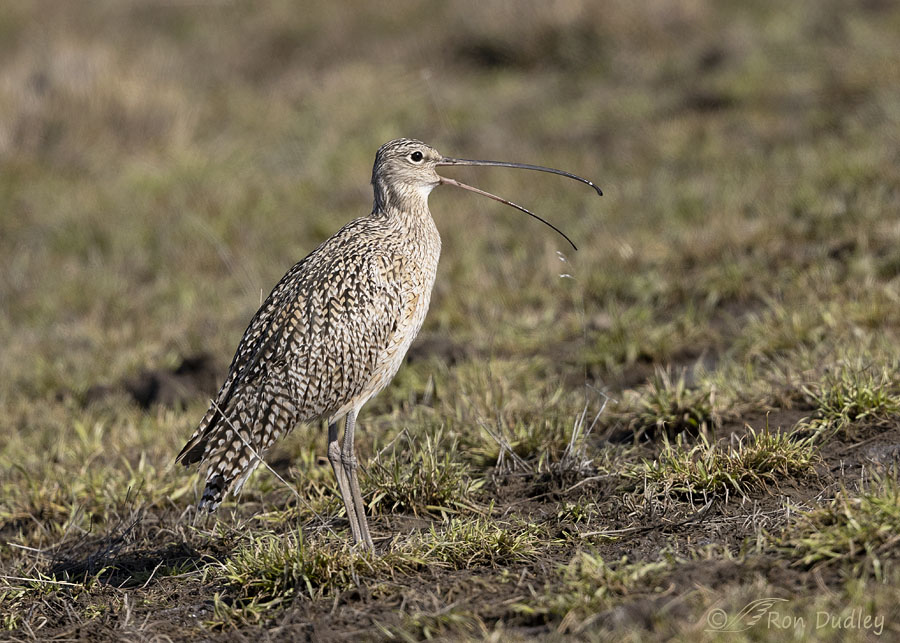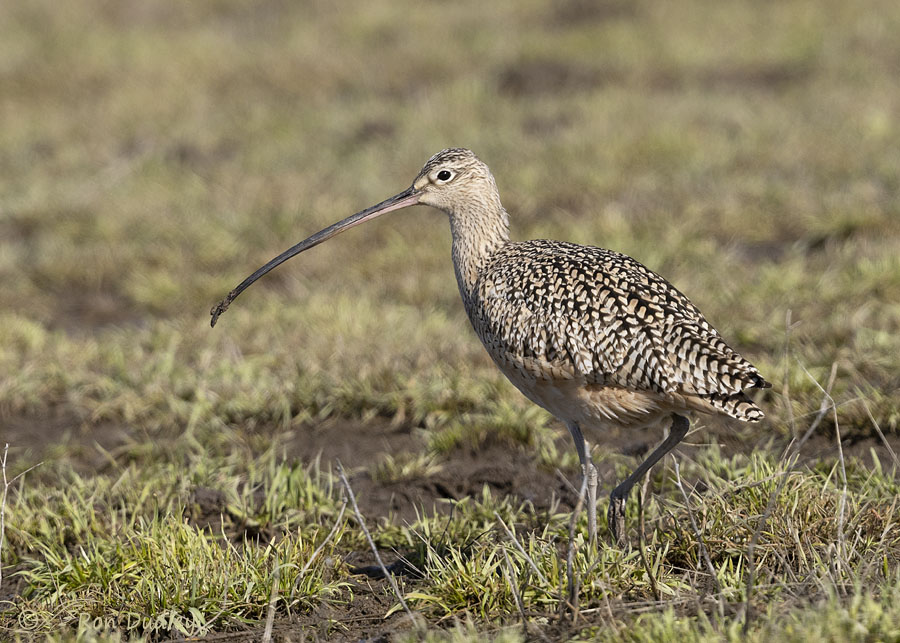I seldom post photos of Long-billed Curlews in early spring because I usually find them in places like Antelope Island where they’re typically surrounded by tall, dead, and unattractive vegetation. Very often they’re largely obstructed by it.

1/4000, f/6.3, ISO 640, Canon R5, Canon EF500mm f/4L IS II USM + 1.4 tc, not baited, set up or called in
But two days ago I found this male near a snow-melt ‘pond’ in northern Utah, where the wild grasses were greening up but still short so there were almost no obstructions in front of the bird. At first he was strongly backlit but after some highly creative driving on a country road I managed to get him in good light.

1/5000, f/6.3, ISO 640, Canon R5, Canon EF500mm f/4L IS II USM + 1.4 tc, not baited, set up or called in
After a few minutes he suddenly started calling loudly and persistently, which made me wonder if his mate was nearby.

1/5000, f/6.3, ISO 640, Canon R5, Canon EF500mm f/4L IS II USM + 1.4 tc, not baited, set up or called in
She was. It didn’t take her long to respond to his calling by flying in, seemingly from out of nowhere, and landing within a few feet of him. Notice how much longer the bill of the female is than that of the male – a relatively easy way to distinguish the sexes of this species.
After a short time with the curlews I left them to look for other birds. Ten minutes later I found the three Ospreys I posted photos of yesterday. It was a good morning for bird photography.
Ron


I put off reading…or simply delete…most emails, but I read yours immediately. Thank you for the wonderful images and information that goes with them.
Am I correct in thinking that the tip of the curlew’s beak has nerve endings and is somewhat flexible?
Pat, good to know I’m high on your email interest list!
Yes, you’re right on both counts regarding their bills.
I’m guessing that the male was too enthralled by your creative driving or his mate to move. Either way, I’m glad you got these shots. I’m sorry that your back is paying the price, though. That sucks big green prickly ones. Hoping you’ll be back in the saddle…er…driver’s seat soon!
Either way, I’m glad you got these shots. I’m sorry that your back is paying the price, though. That sucks big green prickly ones. Hoping you’ll be back in the saddle…er…driver’s seat soon! 
Thanks for the good wishes, Marty.
The male was moving around quite a bit (I’m not THAT enthralling.). After the female arrived, they both were.
Lovely photos. I hope you recover from you drive soon. I have a hard time with long drives. I stiffen up and it takes a bit to walk normally. Part of the reason I walk or hike so much, keeps the joint working!
Thanks, April. In my case, hiking a lot would put me completely out of commission.
An excellent morning.
How is your back today?
It was, EC. It’s better than it was yesterday but not as good as it was before I spent 7 hours driving on the day I took these curlew photos. Takes time to recover…
Nice post and images, thanks also for the BirdNote link, and thanks to Lyle for the reference to your 2014 post about the curlew chick. Just hard to imagine the bill growing to such an extreme length in so little time. Birds are amazing!
” hard to imagine the bill growing to such an extreme length in so little time”
Kind of like the Pinnochio of the bird world. Well, sort of. Thanks, Chris.
Great photos of a biird I seldom get to see I have to travel a few hours to the Great Basin country of southeastern Oregon to find them. When I do they are often at a distance so it’s nice to see them up close. I don’t have a good answer as to why the females bill is longer. This is a pattern found in many shorebirds where females are larger and have slightly longer bills. The Long-billed Curlew is our largest shorebird so the differences may seem more extreme and easier to observe. The fact that she is also larger and heavier is hard to see in the field but bill length is a good clue to sex. The female’s bill is also a bit more curved at the tip. For either sex, that long beak allows probing deeply for burrowing shrimp, crabs and other invertebrates and the female may probe a bit deeper than the male. This deep probing you will mostly see during the non-breeding season when they are often on estuarine mudflats. When on the grasslands during the breeding season they generally just pick prey from the surface with only occasional probing for earthworms.
Thanks for that background, Dan. I only remember seeing a curlew pull up an earthworm one time and I don’t believe I got any photos of it.
You have a very impressive library of Long-billed Curlew photos and behaviors. I encourage folks to click on the Numenius americanus tag. The 2014 photo of the chick points out the incredible bill growth, and “the Mystery of the Curlew Egg” is a great story.
I saw a Whimbrel several years ago. It was dwarfed by the Curlew standing beside it.
Thanks very much, Lyle. Here’s links to the two posts you mentioned for any readers who might like to see them.
https://www.featheredphotography.com/blog/2014/05/20/long-billed-curlew-chick-and-the-length-that-bill-must-grow/
https://www.featheredphotography.com/blog/2012/05/23/the-mystery-of-the-curlew-egg/
VERY interesting and the egg is intriguing!
these are super photographs Ron. What amazing looking birds. I cannot help but wonder why the female’s bill is so much longer than the males. Seems like it would make feeding the young very difficult. I have a great horned owl’s nest containing two very large fluffy nestlings in my yard near the top of a tall pine tree. Hard to see them even with my spotting scope. Can’t get my camera to work with my new lens. It has been frustrating that I am missing so many photographs of the chicks. I’m so glad you are back up to speed with birding and your amazing photography!
Melanie, lens/camera problems are no fun, especially this time of year when opportunities with birds improve. I hope you solve your problem soon.
Wonderful! Love long-billed curlews. I also got a kick out of “highly creative driving.“ I remember the first time I went birding with a “real“ birder… When I said stop, he stopped. He didn’t drive a quarter of a mile down the road and then stop.
Ellen, my “creative driving” techniques when I’m photographing birds would give a driver’s ed teacher nightmares. However, I only use them on deserted roads, dirt roads or no roads.
What long bills! So bizarre!
Was fortunate to see two baby red tails in their nest yesterday! A first for me!! The nest is high and nestled in a saguaro arm at our golf course. The parent hangs out on top of the saguaro. So striking!!
Bizarre indeed, Kathleen.
Neat about your red-tails. I’m not sure I’ll be able to photograph pre-fledgling red-tails this year. Prospects aren’t looking great.
Interesting post. Did not know about the bill length difference in the sexes of the Long-billed Curlew. The BirdNote audio noted that the Long-billed Curlew is North America’s largest shorebird.
Yup, they’re pretty big, Michael – more than 2 1/2 times larger (by weight) than Willets for example.
NICE! They ARE hard to catch in the open unless they’re flying. How they navigate with those long beaks is beyond me! I haven’t seen any in several years. 30 years ago they were common in the wheat fields up top – suspect that was their undoing…..
How they navigate with those long beaks is beyond me! I haven’t seen any in several years. 30 years ago they were common in the wheat fields up top – suspect that was their undoing….. 
The 2 male gold finches that wintered with us have completed their molts to summer colors – 1st time I’ve been able to watch that transformation…..
Judy, I don’t remember ever seeing curlews on or near the Cut Bank farm. I wonder why – it includes some grasslands.
Thanks for both the photos and the audio link………I wonder what kind of
functional adaptation would cause the females to have a longer bill, when
the male’s is already so much longer than most species’ ? You’d think she’d
topple over…….there must be some reason ?
Good question, Kris. Wish I knew. Maybe Dan Gleason will chime in on this.
Excellent opportunity and photos Ron. Always amazed at that long bill. I got photos of them in shallow water here about four years ago and have never seen since.
Thanks, Everett.
Wow! Those are gorgeous shots. The second shot of him calling is just fabulous. I’ve never seen a shot of a female so that bill was an interesting tidbit. I love it when the roads are empty and that kind of creative maneuvering is possible.
Granny Pat, getting on the other side of the birds where the light was better was a challenge. Thankfully the curlew tolerated my maneuvering and didn’t fly off.